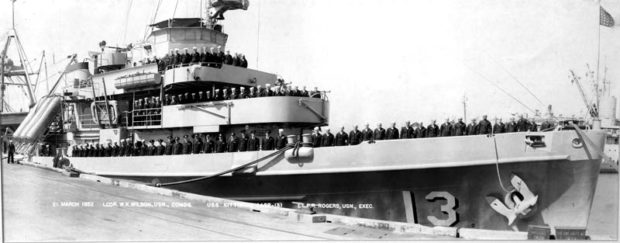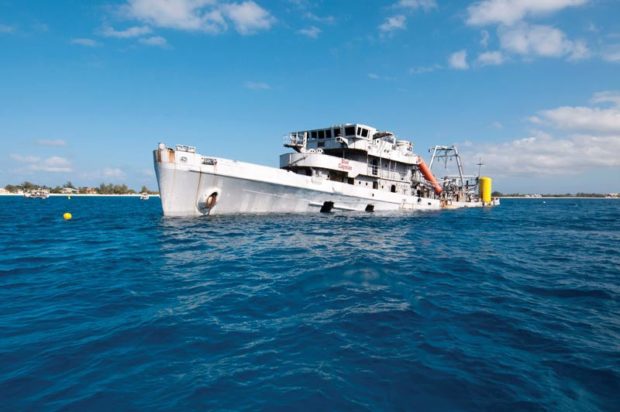Return to the Kittiwake
One of diving’s most iconic artificial reefs, Grand Cayman’s Kittiwake, is revisited by one of its former crew members
Words and Photography by Drew McArthur

a respectful salute to his former home, the vessel’s name is still clearly visible on the stern. Photo: Drew McArthur
A naval vessel is much more than just a place of work and a roof above the heads of the people who serve on her. The chunk of metal that the crew call home for a portion of their lives may be the birthplace of lasting friendships, life-changing adventures, and the kind of stories that are incomprehensible in civilian life. So how must a sailor feel when such a vessel is retired to the ocean and sunk to make an artificial reef? Ex-US Navy Petty Officer Pete Larson found out on his recent visit to the Cayman Islands
The ex-USS Kittiwake currently lies at around 70 feet (21m) below the surface of the Caribbean Sea in Grand Cayman. In addition to conducting salvage operations, the 251 foot (76.5m)-long Auxiliary Submarine Rescue (ASR) vessel was designed to assist submarines should they become stricken underwater. After a 50-year career that began just after the Second World War, the Kittiwake was decommissioned in 1996 and sat idle in Norfolk, Virginia, where she waited for her destiny to unfold. She was later acquired by the Cayman Islands and, on January 5th, 2011, she was sunk to make an artificial reef and divers’ playground.
The single most important function of an ASR ship during those times was to bring the crew of a submarine to safety in the event their vessel had ceased to function while underwater. According to Larson, “The Kittiwake would fix its position in the water using four floats that were anchored to the ocean floor. Once we were tied into the middle of these floats, the rescue hatch would drop to the submarine below and make an airtight seal enabling the submariners to climb out and be brought to the surface.”

During the years of 1986-89, Larson was an engineer on the Kittiwake and would regularly play his part in performing this rescue operation in various training scenarios. Larson’s day-to-day work would be whatever tasks filtered down from on high but, “Everything revolved around the sub rescue chamber. Every job on that ship was designed to make that chamber go over the side and mate to a submarine,” he explained.
Just as the crew were expected to perform a wide range of work duties, the Kittiwake herself was assigned to a variety of jobs. Most notably, the vessel’s search and recovery skill set led her to be drafted into the operation to recover wreckage from the Challenger disaster. Although the mission was short, the extreme tragedy of the shuttle explosion made this brief period stand out in the Kittiwake’s history.
Anyone who has dived the Kittiwake with a dive operation in Grand Cayman likely will have been given an animated briefing about the life of the vessel. The Kittiwake is a source of pride for Divemasters (DMs) on the island, as many consider the wreck to be a highlight of their diving adventures. These briefings often reference the involvement with the Challenger salvage operation and are sometimes punctuated with a story about how she recovered the black box from the wreckage. According to official reports from NASA & the US Navy, however, this piece of Cayman lore can’t be true. The Kittiwake was indeed on the job and did assist with recovery work but it was actually one of the Challenger’s Solid Rocket Boosters (SRBs) that she recovered from a depth of 177 feet (54m). According to a source in NASA, the Challenger didn’t even have a black box to start with! How that mistruth began is unknown, but the false claim to fame has been published in a wealth of outlets since and likely will continue to be referenced in dive briefings, as most DMs will appreciate that the truth shouldn’t get in the way of a good story.
During Larson’s time, the ship’s divers’ workload was a mixed bag. They were primarily engineers, who first and foremost had normal jobs on the boat. “Nowadays, Navy Diver is a rate by itself, but back in the 80’s you had to be something else, like an engineer or a Boatswain’s Mate; you had to have a job in the navy that was conducive to being a diver.”

Current affairs
The Kittiwake has been resting off Seven Mile Beach in Grand Cayman for over eight years now and in that time has been the focus of much attention. Whilst being an attraction to tens of thousands of divers and snorkelers each year, the wreck has featured in just about every scuba diving magazine, been the backdrop for a range of underwater videos and often features in published “Top Ten” dive listings. The Kittiwake was originally set in the sand in an upright position but over the years surge from a series of offshore hurricanes has shifted the vessel on to her side. In spite of this new positioning, the wreck is still very much intact and accessible for a range of divers to enjoy.
On the day of the dive Larson checked in with local dive operator Divetech, who had been instrumental in the acquisition and sinking of the Kittiwake. Once aboard the dive
boat he commented, “I’ll be curious to see what they left on it and what the government had removed to avoid polluting the water. Back in the day, there was a lot of asbestos used on the Kittiwake, which was removed when they realised it was a bad product.”
Prior to Sinking, significant portions of the Kittiwake were removed to make her safe in her new environment. As well as ensuring the wreck was non-hazardous to marine life, any potential diver snag or entrapment hazards were also sealed off or removed. At the same time, larger access holes were cut throughout so that divers could swim from end to end without having to exit the wreck.
The dive itself was a typical day out on the Kittiwake. Flat surface conditions, superb light penetration, no current, and 90-foot (27m) visibility made it considerably more easy going that the lakes that Larson is more commonly accustomed to. He said, “When we jumped in I was thinking about what it was going to look like when I saw it. I was thinking of it on the pier the last time I saw it, that was the last image I could recall. Now it is on its port side and the pilothouse is gone, so it took a little while before I could tell it was the Kittiwake. It was pretty neat to see.”
The return to his old home did indeed bring back memories for Larson, “I particularly looked at the decks because I remembered how much we had to paint them. We painted them so often I thought I’d see an inch and a half [4cm] of paint holding them together.”
The dive began on the outside and ran the length of the ship from the bow to the stern. Along the way, Larson and his dive buddies observed the helm, the wheel now exposed but still there. The roof was lost to a storm, which is a reminder of the inevitability of the eventual demise of the wreck. Continuing on, they passed the smoke stack leading into the belly of the wreck, the water cannon on which he recalled being trained on protesters, through the superstructure, along the boom that he recalls being used in the rescue drills, around the stern where the name “Kittiwake” can still be seen, eventually arriving at the swim-through created by the propeller and the rudder. Memories of the working vessel were stirred up and re-ignited.
“I was interested to see the spuds were still on it, that’s what they called the floats stored on either side of the ship. I didn’t remember that till we swam up to them and I actually touched one of them.”
Shortly after penetrating the wreck through a hatch on the rear deck, the group arrived in the forward engine room, which was Larson’s place of work as an engineer. Following the dive he mused, “Memories depend on what kind of person you are. I don’t have any negative memories of my time there, in fact I think to some degree that was what I needed as a young man, to be in the military and to be straightened out.”
Once the tour of the inside was over, the group’s air supplies dictated an end to the dive. Larson’s last look at the Kittiwake was from in front of the bow, as he turned to face the fine vessel that he once sailed upon the high seas he took the opportunity to give a final salute. Once again the wreck began to fade into his past as the divers slowly headed back to the boat.

still remain
The verdict
The Kittiwake in her current incarnation as a dive attraction and artificial reef is a very different beast to when she roamed upon the high seas. As a working naval vessel the ship would have been bustling with life with service personnel aboard living out their days painting, cleaning, diving, salvaging, and doing anything else that was required of them. The wreck still bustles with life but now it is the battalions of jacks, barracuda, parrotfish, and other marine creatures that have made a home in the rusting structure.
For Larson this reunion with the Kittiwake was a dive down memory lane that brought about significant nostalgia and good memories. His physical presence as a diver on the wreck in which he once lived and worked created a link between the Kittiwake’s two distinctly different existences. In this brief moment of the Kittiwake’s life cycle, old and new were joined together.
PO2 Larson is an avid diver and wreck enthusiast, as such he compared this dive to other deliberately-sunken wrecks he has seen, “The dive made me think of the Orinskany and the Vandenberg. They are kinda still serving, just in a different capacity and I think that’s pretty cool. I think they should do more of it, I’d like to see the coral grow and not die, and if the ship will help that then that’s a good end for it.”
You may think that an old sailor would resent seeing his ship at the boom of the sea but Larson had a different outlook: “It was pretty cool to be back on the Kittiwake, just to see it again, you know? To see how it continues on. Not cut up in a Louisiana junk yard for scrap metal, it actually has a purpose now. It has lots of life on it and it’s a very good dive, I highly recommend it.”
Leave a Comment







